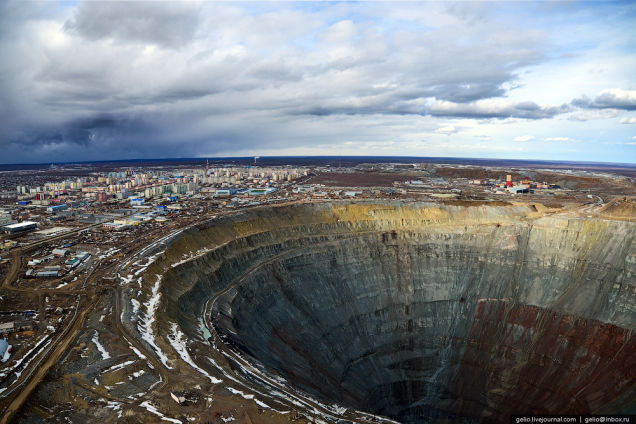The Nearly Mile-Wide Diamond Mine That Helped Build the Soviet Union
Post Date: 23 Jun 2014 Viewed: 344

Building empires takes money. And building industrial empires takes diamonds, not just for cash, but for the machines and tools that need them to operate. In a remote corner of Siberia, the Mir diamond mine was responsible for funneling diamonds into building the USSR—and it left behind a pit that stretches almost a mile across the surface of the Earth.
Slava Stepanov, aka Gelio, is a Russian photographer who lives in Novosibirsk, a city that sits on the Mongolian steppe above Kazakhstan and Mongolia. From his home base, Stepanov travels around central Asia shooting cities, infrastructure, and other artifacts of human civilization from above. Those range from the northernmost city on Earth to the biggest dam in Asia.
This spring, Stepanov made a visit to a town in the far north of Russia that few people know about, but that had a crucial hand in making Russia what it is today: Mirny, a city of 37,000 that sit smack dab in the middle of, well, seemingly nowhere. It was here that, in the 1950s, Russian geologists discovered Kimberlite—a mineral that often means diamonds are nearby—after Stalin sent a team of geologists to scour eastern Siberia for the stuff.
By the late 1940s the fledgling Soviet Union was in desperate need of diamonds, not just for their monetary value, but for industrial purposes: For drill bits, for example, and scouring materials.
And so off teams of scouters went, culling the Siberian wilderness for evidence of diamonds. And in the northeastern corner of Siberia, they found them. The Mir Mine, and the town of Mirny that sits on its precipice, was founded in 1955. It would grow to become the second largest hole in the world—nearly a mile wide at its mouth.
Only a mine as lucrative as Mir could be worth this much trouble: The temperatures in Mirny are so cold, it's almost impossible to dig into the ground for most of the year. Rubber freezes. Steel snaps. According to Abazias, the engineers went to extreme lengths to dig the pit:
Utilizing jet engines, the Soviets would burn through the layer of permafrost to get to the soil beneath it. Where the ground was too solid or too frozen for jet engines, they would use dynamite to blast holes from which they would then work outward from.
And the town of Mirny? Well, it's built on steel stilts, since the permafrost is too soft to hold conventional buildings. But over 44 years, Mir came to rival even South Africa's diamond trade, producing two million carats of diamonds every year. Mirny became a boom town.
But according to De Beers and other diamond dealers, there was something odd about the diamonds coming out of Mir. Abazias explains:
These diamonds were all of a uniform size and shape and were dubbed 'Silver Bears'. While DeBeers could not understand how the Soviets were producing such a large quantity of gem diamonds of such uniform size, and supposedly from one mine that by DeBeers surveys should not be capable of such diamond production, they were, nevertheless, pressured to purchase them all lest the Soviets simply dump the diamonds on the open market, thus flooding it and bringing down diamond prices.
The USSR, unsurprisingly, wasn't hugely open to outside investigators—and so the mystery of the Silver Bears was never solved.
Today, Mir is closed. It was shut down in the 2000s. But mining continues beneath this hulking void, through dozens of tunnels where mining machines parse the rock for diamonds. It still nets an impressive haul: Roughly 4,409 pounds of diamond per year.
Stepanov actually got to visit the diamond processing plant himself, and brought back images of the incredible industrial machines that wash and sort what'd discovered below the permafrost. Then, just like in Soviet times, an actual human assesses the value—some things never change.
Beyond the mystery of the diamonds, the most bizarre thing about Stepanov's photos is Mirny itself, a city perched on the edge of a hole so deep it affects the atmosphere above it. Helicopters can't fly over it—the downward force of the air would pull them in. You can see it from space.
But it's easy to imagine how, from the ground, you might even forget it's there. It's only from the air that Mir's terrifyingly huge pit, dug into the frozen tundra, finally reveals itself.



